- Quick Read
- Deep Read ( 7 Min. )

Why is Christian Science in our name?
Our name is about honesty. The Monitor is owned by The Christian Science Church, and we’ve always been transparent about that.
The Church publishes the Monitor because it sees good journalism as vital to progress in the world. Since 1908, we’ve aimed “to injure no man, but to bless all mankind,” as our founder, Mary Baker Eddy, put it.
Here, you’ll find award-winning journalism not driven by commercial influences – a news organization that takes seriously its mission to uplift the world by seeking solutions and finding reasons for credible hope.
Explore values journalism About usMonitor Daily Podcast
- Follow us:
- Apple Podcasts
- Spotify
- RSS Feed
- Download
TODAY’S INTRO
Kindergarten diplomacy
 Mark Sappenfield
Mark Sappenfield
Many of us have heard of the book “All I Really Need To Know I Learned in Kindergarten,” and there is wisdom in the title. In her review of five children’s books today, Monitor writer Husna Haq offers wisdom of her own: The books “show the beauty and growth that comes with viewing the world through someone else’s eyes.”
On the surface, two of our other articles today might seem the opposite of children’s stories. Columnist Ned Temko writes about the enduring value of a two-state solution in Israel, and Howard LaFranchi chronicles the United States’ demand that Israel do more to safeguard Palestinian citizens. These stories are about diplomacy, yes. But they are also about something we learned in kindergarten: Earnestly considering another’s perspective fuels growth and peace, not just at recess but at every stage of life.
Share this article
Link copied.

Help fund Monitor journalism for $11/ month
Already a subscriber? Login

Monitor journalism changes lives because we open that too-small box that most people think they live in. We believe news can and should expand a sense of identity and possibility beyond narrow conventional expectations.
Our work isn't possible without your support.
Why US-Israel divide over war in Gaza is widening
The United States is exhorting Israel to do more to protect Palestinian citizens. There are some signs Israel is listening. But internal Israeli pressures are widening the space for disagreement on a host of key issues. For the U.S., tough questions are only getting tougher.
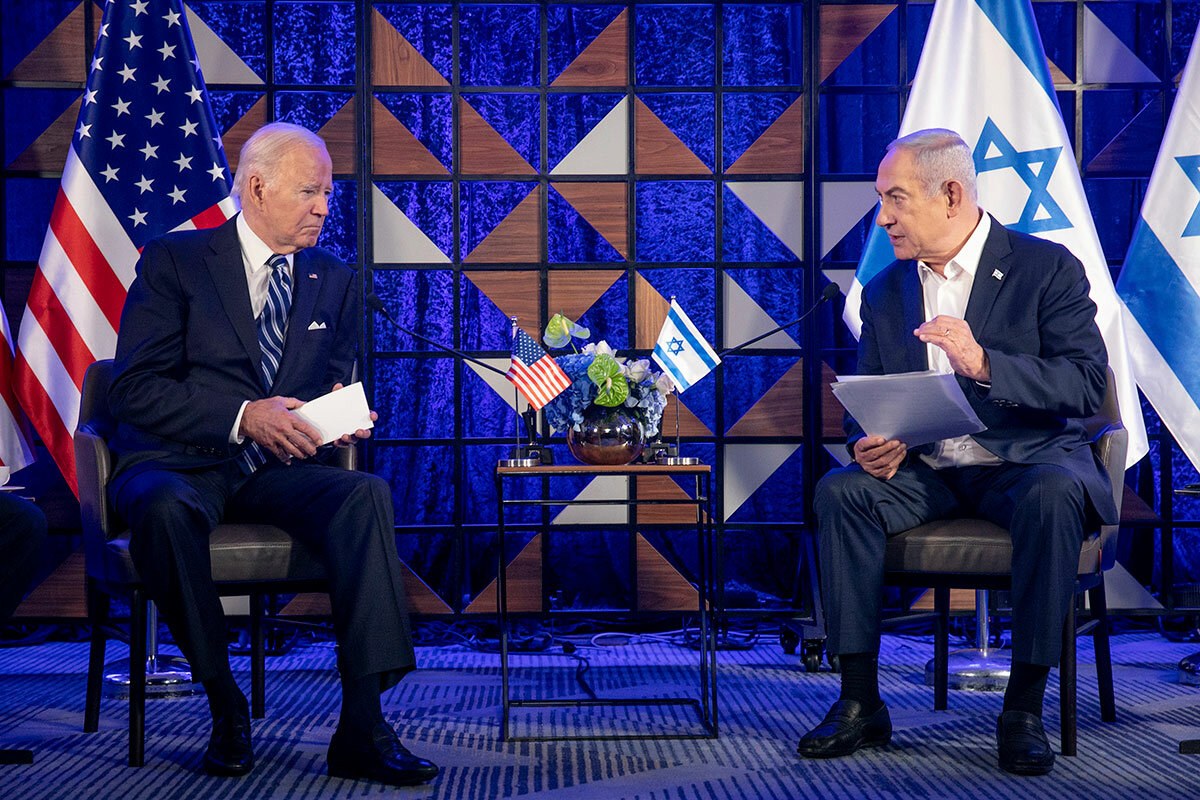
-
Neri Zilber Special contributor
As the war in Gaza enters its third month, the Biden administration is toughening its demands on Israel over conduct of the war – an acknowledgment of shifting U.S. public opinion and of increasingly agitated Arab allies. In response, Israel is pledging to carry out its campaign in southern Gaza with greater precision and care for limiting civilian casualties than it did in the north.
But Prime Minister Benjamin Netanyahu faces internal pressures, too. They come from an Israeli public, hardened by Oct. 7, that will accept nothing less than the promised “destruction” of Hamas. And they come from extremists in the government determined to use the war to pursue their vision for handling the broader Palestinian conflict.
These countervailing pressures are setting the stage for looming clashes that will test Washington’s “ironclad” support for Israel.
“Absolutely a number of conflicts are brewing” over the war and its aftermath, says Doron Ben-Atar, a historian at Fordham University in New York.
“Washington’s timer for the military operation is ticking faster than Israel’s,” he says, while “the two visions for what comes after the war are very different. The U.S. and the rest of the world ultimately want a Palestinian state to come out of this,” he adds. “Netanyahu and his right-wing government are opposed, to say the least.”
Why US-Israel divide over war in Gaza is widening
As the war in Gaza enters its third month, the Biden administration is toughening its demands on Israel regarding the conduct of the war – an acknowledgment at least in part of shifting U.S. public opinion and of increasingly agitated Arab allies.
In response, Israel is pledging to carry out its campaign in the southern Gaza Strip with greater precision and care for limiting civilian casualties than it did in the north. The war there in recent weeks has caused widespread devastation and inflicted a high civilian toll among Palestinians.
But Prime Minister Benjamin Netanyahu faces internal pressures of his own. They come from an Israeli public, hardened by the Hamas attack of Oct. 7, that will accept nothing less than the promised “destruction” of Hamas. And they come from the extremists in Mr. Netanyahu’s government, who are determined to use the war to pursue their vision for handling the broader Palestinian conflict.
These countervailing pressures are setting the stage for looming clashes that will test what to now has been Washington’s “ironclad” support for Israel in its war on Hamas.
“Absolutely a number of conflicts are brewing” over both the war and its aftermath, says Doron Ben-Atar, a historian of Middle East conflicts at Fordham University in New York.
“Washington’s timer for the military operation is ticking faster than Israel’s,” he says, while “the two visions for what comes after the war are very different. The U.S. and the rest of the world ultimately want a Palestinian state to come out of this,” he adds, “while Netanyahu and his right-wing government are opposed, to say the least.”
The clashes over postwar visions are almost certain to surface much sooner than any negotiations on an independent Palestine, which are far off at best.
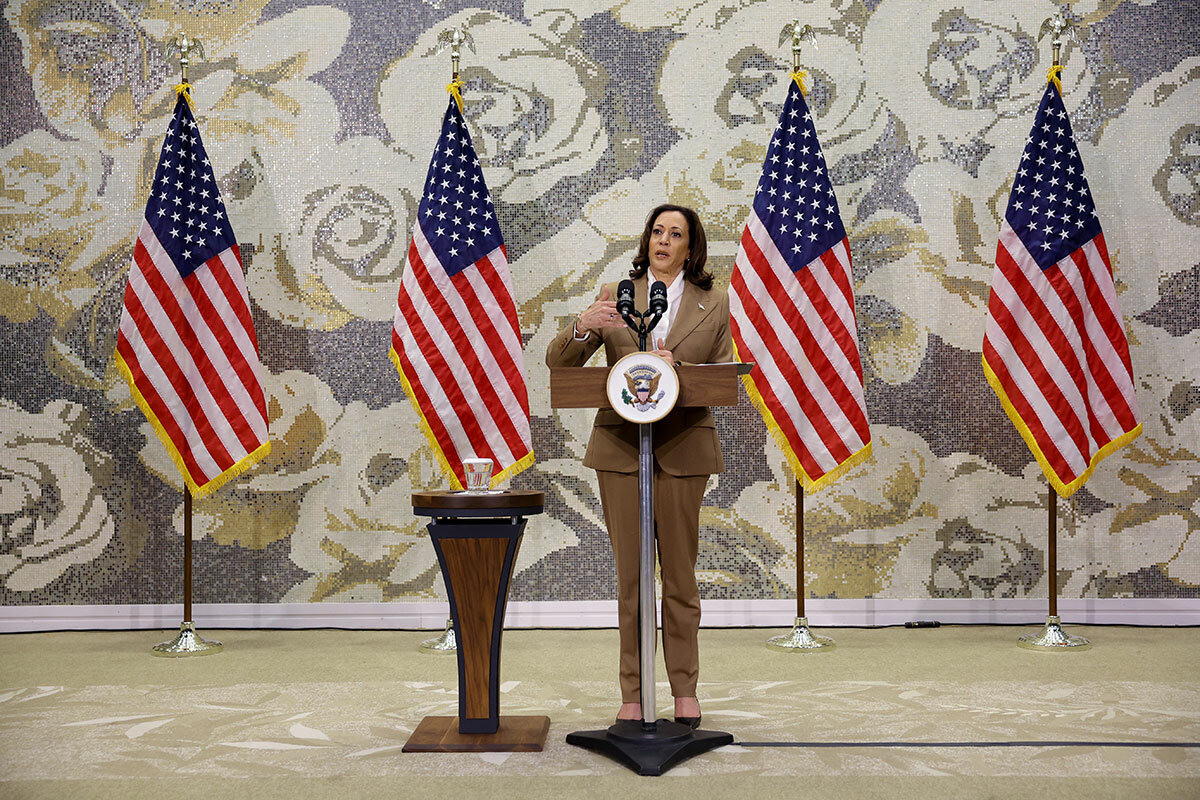
U.S. “principles” over Gaza
On a hastily organized trip to Dubai over the weekend, Vice President Kamala Harris laid out a list of “principles” that the United States says should guide the future of a postwar Gaza.
In a statement summarizing Ms. Harris’ conversation Saturday with Egyptian President Abdel Fattah al-Sisi, her office said, “Under no circumstances will the United States permit the forced relocation of Palestinians from Gaza or the West Bank, the besiegement of Gaza, or the redrawing of the borders of Gaza.”
But on almost every count, the Israeli government is staunchly opposed to, and is floating proposals that fly in the face of, the U.S. demands.
For now, however, Israeli political and military officials acknowledge that their offensive into south Gaza, which has reached the Hamas stronghold of Khan Yunis, Gaza’s second-largest city, will have to be conducted more carefully.
The southern offensive “will be different than what happened [over] several weeks ... in the north,” one senior Israeli official acknowledged late last week. “We see eye to eye with the American administration” on the goals of the war, he added. “The focus is on eliminating this terror group ... and to make sure civilians are out of harm’s way.”
The Israeli government and military have received the Biden administration’s message loud and clear.
Speaking on the condition of anonymity, one person familiar with U.S.-Israel discussions says the southern offensive “has to be done with a smaller military footprint. You can’t have the same number of civilian casualties in the south than in the north, you need a clear humanitarian plan, and you need to have places where civilians can go.”
Mr. Netanyahu has acknowledged the need to acquiesce to Washington’s demands to some extent, saying Saturday, “If you don’t have the international space, you won’t have the military space.”
Still, it remains unclear to what extent Israel really is heeding the pressures from the U.S. and international voices, including the United Nations, to head off a humanitarian catastrophe. Wednesday night the Israeli security cabinet finally approved a small increase in humanitarian aid into Gaza – despite opposition to the measure from hard-liners in the Netanyahu coalition.
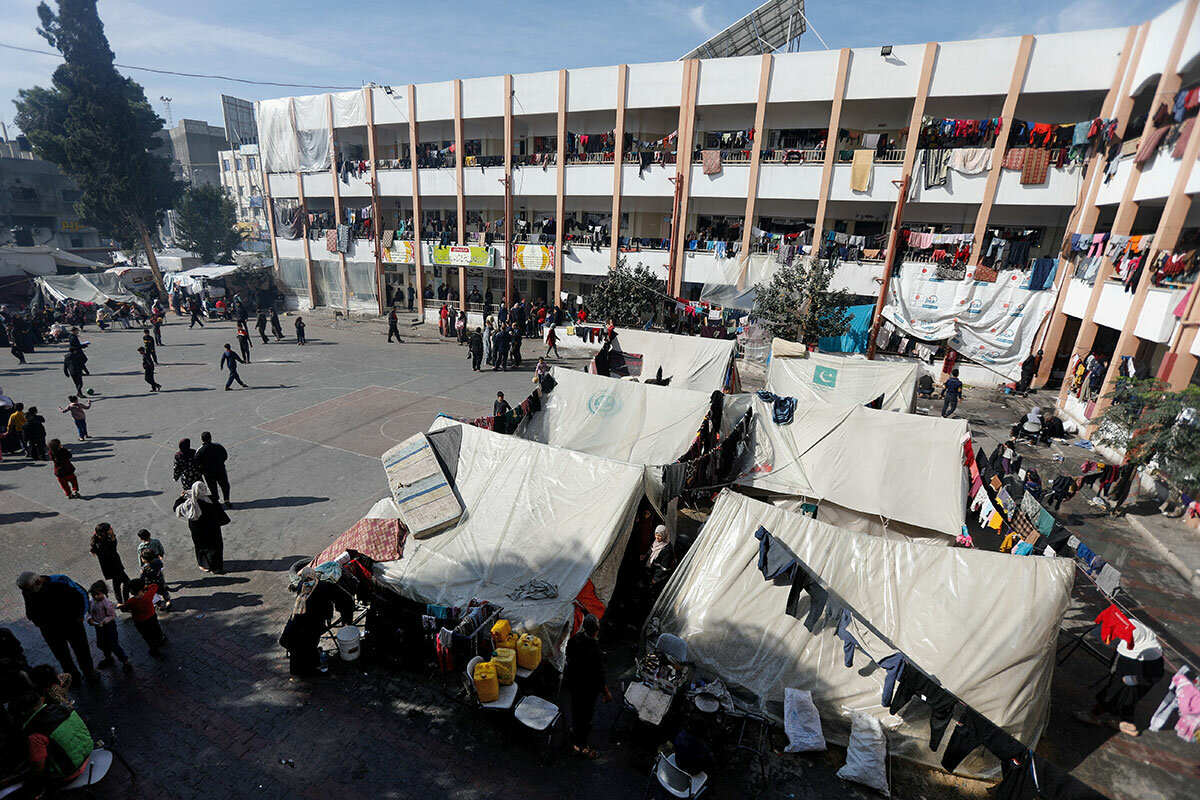
What’s different this time
The shifts from what initially was unbridled U.S. support, and Israel’s efforts to appear responsive to its most critical ally’s demands, fit a pattern of past Israel-Hamas conflicts, some longtime experts in U.S.-Israel relations say.
Except that this time, they add, things are different.
“One difference is that Israel was allowed a longer leash because of the terrible brutality of Oct. 7,” says Fordham’s Dr. Ben-Atar. “But what is radically different,” he adds, “is that the U.S. can’t actually push Israel to stop fighting, because this time it’s the Israeli people who are demanding that the war not stop as long as Hamas is in control of Gaza.”
Indeed, the view of an overwhelming majority of Israelis, according to opinion polls, is clear. They believe the war must not end until Israel’s objectives are met: destroying Hamas as a military and governing force in the Gaza Strip, and retrieving all of the estimated 140 remaining hostages.
That view was on display at a highway junction not far from the Gaza frontier in south Israel Wednesday, as one older Israeli man said while handing out sandwiches and drinks to uniformed and armed soldiers. “This is the most just war that’s ever been,” said the man, who identified himself only as Yair. “And if the government doesn’t go all the way and finish the job, then we will.”
Young Democrats shifting
In the U.S., the political calculations are very different, however, with President Joe Biden facing mounting pressure from key Democratic constituencies to rein in Israel and stop the war.
“We’re seeing a real shift in American opinion, but most significantly among the president’s key constituencies, from an initial spike in support for Israel after the Hamas attacks to greater concern about high civilian casualties and support for a cease-fire,” says Shibley Telhami, a professor of government and politics at the University of Maryland and director of the university’s Critical Issues Poll.
“Among young Democrats in particular,” he adds, “we’re seeing a clear shift to the Palestinians – even less willingness to vote for Biden again over his strong pro-Israel stance.”

White House officials insist Mr. Biden has been increasingly forceful in his private conversations with Mr. Netanyahu. Yet “the time is coming,” Dr. Telhami says, “especially as we enter an election year, when the president is going to have to take account of the [public opinion] warnings and speak out on this himself.”
Another clash is brewing over who should govern a post-Hamas Gaza.
In public remarks over the weekend, Vice President Harris said the Palestinian Authority, which has partial control of the Israeli-occupied West Bank, should eventually govern Gaza – espousing a solution sketched earlier to some degree by Mr. Biden.
“The Palestinian Authority must be revitalized, driven by the will of the Palestinian people,” she said. In addition, PA security forces “must be strengthened to eventually assume security responsibilities in Gaza.”
But there is little doubt over Mr. Netanyahu’s total rejection of this position.
“We would be putting the same element – utterly unreformed, utterly unchanged – into Gaza, and that’s ... what even the best of our friends suggest,” the prime minister said Saturday. “I think differently,” he added. “I think we need to build something else.”
What that “something else” might be remains unclear, although many Israeli analysts say the day is fast approaching when the government is going to spell out its postwar plans for Gaza.
Governments’ durability
Yet even as the Israeli government and the Biden administration attempt in coming weeks to meld their visions for the future, they will face daunting stumbling blocks, some experts say.
Mr. Biden faces a reelection bid next year that a number of recent polls suggest “he could very well lose over this,” Dr. Telhami says.
Moreover, many political experts in both Israel and the U.S. have strong doubts that Mr. Netanyahu, whose support in polls is at low ebb, can survive politically after the war.
But perhaps the biggest obstacle to any lasting peaceful resolution of the war will come from the Israeli and Palestinian publics themselves.
“In my mind, I can draw the borders of a Palestinian state that includes Gaza. I can picture how that state could be secured in a way that allows Israel to live in security,” Dr. Ben-Atar says.
“But for any of that to have a chance to work, the people have to trust each other, and I can tell you there is zero trust,” he says. “Right now there is a complete breakdown of trust between the two sides, and that’s not going to be fixed soon.”

Nikki Haley has some momentum. Her challenge is still immense.
Is there place in Republican hearts for a Donald Trump with “a polite way”? Filling that role has given presidential candidate Nikki Haley momentum, and there are indications the share of “always Trumpers” in the party has dropped since 2020. But her task is enormous.
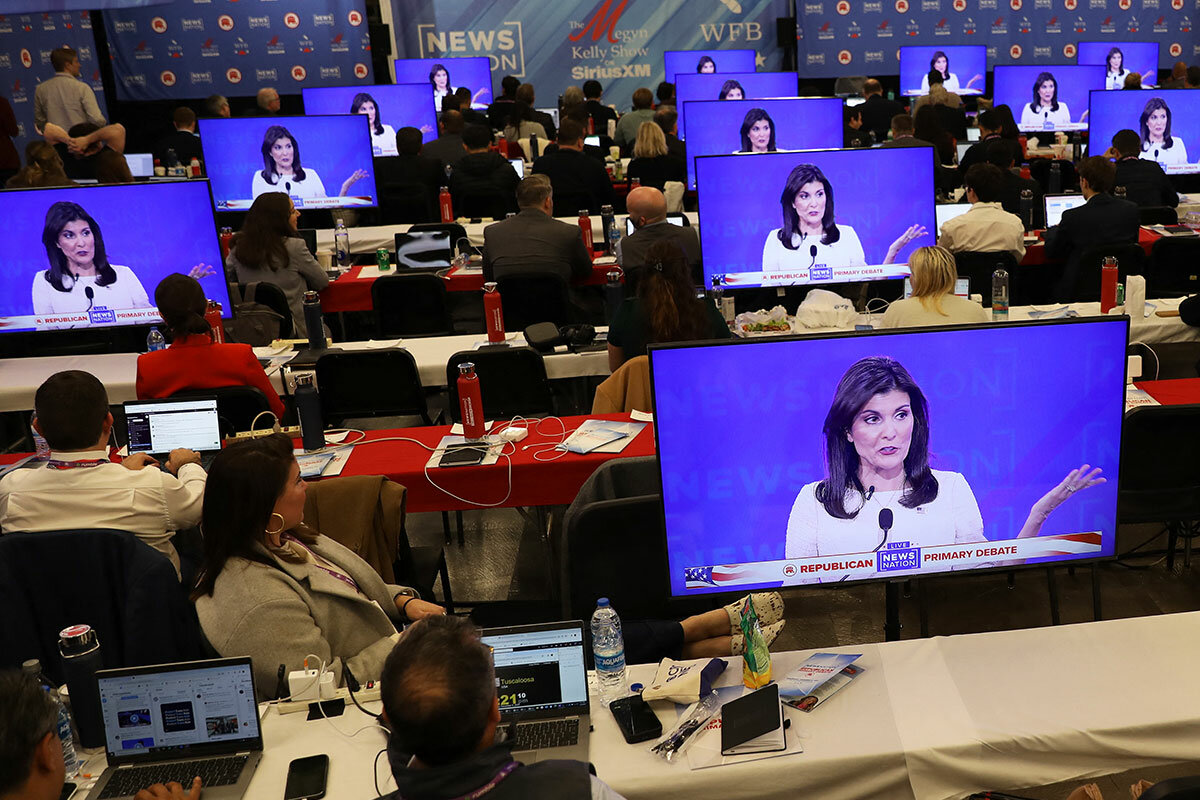
- Quick Read
- Deep Read ( 7 Min. )
Nikki Haley is having a moment. With one month to go before the first presidential nominating contest, the polls, fundraising, and energy are all on the upswing for the former South Carolina governor – boosting her argument that she is best positioned to challenge former President Donald Trump for the GOP nomination.
Last week, the political network founded by billionaire brothers Charles and David Koch endorsed Ms. Haley. Polls now have her in a clear, albeit distant, second place behind Mr. Trump in New Hampshire and South Carolina. And in a telltale sign of a candidate’s momentum, her opponents came out of the gate attacking her at the final Republican debate last night.
The question is whether any of it will matter. Despite facing multiple criminal indictments, former President Trump remains the overwhelming favorite among Republican voters, leading the field by 20 to 50 points.
Haley supporters here in South Carolina note that she was an underdog in her first, successful campaign for governor. Despite the odds, they are hoping she can pull off an upset for the ages.
“Nikki’s policies would be similar [to Mr. Trump’s],” says Sharon Carter, a retired elementary school teacher who chairs the Bamberg County Republican Party, “but she would do it in a polite way.”
Nikki Haley has some momentum. Her challenge is still immense.
After blessing the lunch of fried chicken and black-eyed peas with a prayer and ordering a sweet tea, Sharon Carter places her palms on the red-and-white checkered tablecloth at Rusty and Paula’s, the main eatery in Bamberg, South Carolina, and explains why she’s in such a good mood.
Her preferred candidate in the 2024 Republican presidential primary, Bamberg native and former South Carolina Gov. Nikki Haley, is having a moment. With a little over one month to go before the first nominating contest in Iowa, the polling, fundraising, and energy are all on the upswing for Ms. Haley – boosting her argument that she is the one best positioned to challenge former President Donald Trump for the GOP nomination.
Last week, the political network founded by billionaire brothers Charles and David Koch endorsed Ms. Haley, bringing money for TV ads and a ground operation of door-knockers and phone callers. Polls now have her in a clear – albeit distant – second place behind Mr. Trump in New Hampshire and South Carolina, and closing the gap with Florida Gov. Ron DeSantis for second place in Iowa. A town hall last week on the South Carolina coast in Bluffton turned into a rally of 2,500, with hundreds reportedly turned away at the door after the event reached capacity. And in a telltale sign of a candidate’s momentum, her opponents came out of the gate attacking her at the final Republican debate last night in Tuscaloosa, Alabama.

“I love all the attention, fellas, thank you for that,” said Ms. Haley to her three male opponents on stage.
The question is, however, will any of it matter in a campaign year that’s unlike any other? Despite facing multiple criminal indictments, former President Trump remains the overwhelming favorite among Republican voters, leading the field by 20 to 50 points. Ms. Haley’s strong debate performances, which have clearly contributed to her gains in support, have all come with the caveat that Mr. Trump has not participated.
Haley supporters here in South Carolina, many of them former Trump voters, recognize the long odds. Still, they note she was a long shot in her first, successful campaign for governor. And they point to polls showing she does better than Mr. Trump in head-to-head matchups against President Joe Biden. They are hoping that over the next few months momentum will beget momentum – and that Ms. Haley will pull off an upset for the ages.
“There are those that are for Trump because they saw the policies and they agree. But I believe there are more people who are realizing that Nikki’s policies would be similar – but she would do it in a polite way,” says Ms. Carter, a retired elementary school teacher who chairs the Bamberg County Republican Party. “I really believe she’s starting to translate that to folks.”
Overhearing Ms. Carter’s comments as he leaves Rusty & Paula’s with his wife, Kendra, local hay farmer and lifelong Republican Glenn Gustafson says he’s been sending Ms. Haley $47 a month to help her become the 47th president. He’s already told his son that he’ll have to drive him to Washington to watch Ms. Haley’s inauguration if she wins.
“And she can win,” says Mr. Gustafson.
“If Trump wasn’t running, she would,” his wife adds.

Soft Trump supporters
The conundrum that Ms. Haley faces in the GOP primary race – how to attract both Trump-averse Republicans and “Make America Great Again” supporters – is personified by these three South Carolinians.
Ms. Carter, who voted for Mr. Trump in 2016 but then decided to vote for Mr. Biden, “the lesser of two evils,” in 2020 because “character is important,” isn’t sure what she’ll do in 2024 if Mr. Trump is the GOP nominee. The Gustafsons, both two-time Trump voters, are more sympathetic to the former president. His term in office was “chaotic,” they agree, but it was far better than the Biden administration. They’d vote for Mr. Trump next year if he’s the nominee, to get Mr. Biden out of office.
All three, however, see Ms. Haley as the best choice for the party.
“I think Nikki can do the same job as Trump, but without all the crap,” says Mr. Gustafson.
Of course, they all recognize, as they pull up photos of themselves with Ms. Haley in this exact restaurant, that they might be a little biased. Bamberg, one of the least-populated, poorest counties in South Carolina, is Ms. Haley’s hometown. Her presidential campaign announcement video was centered around her childhood here. Rusty & Paula’s, the only dining option in town besides a Hardee’s on the end of a vacant Main Street, features “Haley for President” signs outside and bumper stickers next to the register. Ms. Haley came in here two weeks before her campaign announcement rally in Charleston, says Ms. Carter, who remembers Ms. Haley from middle school, to let her hometown know she would be running.
“If she continues to rise, the independent and female voters will get behind her more and more,” says Ronny Maxwell, a banker in Bamberg who has voted Republican for the past four decades, including twice for Mr. Trump.
“Our country needs someone who can put 100 percent into presidential duties,” he says, adding that he believes Mr. Trump will be too distracted with his numerous trials. “I’m grateful for the progress Trump made in his term, but I’m hopeful for the future. And I think Nikki is our answer.”
Ed Goeas, a Republican strategist who worked on presidential campaigns for both former Wisconsin Gov. Scott Walker and former Ohio Gov. John Kasich, says the number of “Always Trumpers,” or voters who say they will vote for the former president no matter what, has decreased from a majority of Republicans in 2020 to around 40%. The plurality of Republicans today, he says – around 50% – are more like Mr. Maxwell and the Gustafsons: Voters who previously cast ballots for Mr. Trump and still like his policies, but would prefer a different Republican presidential nominee in 2024. Just 10% are “Never Trumpers.”
“I think everyone is misreading the lead that Trump has, because that lead is in a multi-candidate race,” says Mr. Goeas. By campaigning in such a singular way, and skipping events like last night’s debate, Mr. Trump is doing little to expand his “Always Trump” voter pool, he says. And the more other candidates drop out, which Mr. Goeas believes could happen sooner than it did in 2016, “the more it becomes a Nikki-Trump fight,” with supporters of Mr. DeSantis or former New Jersey Gov. Chris Christie moving into Ms. Haley’s camp.
“Haley’s getting the lightning in the bottle at exactly the right time going into the primaries,” he adds.

Will the field consolidate?
Some of Ms. Haley’s rise has come at Mr. DeSantis’ expense. The Florida governor was polling in a strong second place before he even launched his campaign but has seen his support steadily drop ever since. And while Mr. DeSantis has “put all his eggs in Iowa’s basket,” Ms. Haley is “the only candidate that’s in a solid position in all three early states” of Iowa, New Hampshire, and South Carolina, says Olivia Perez-Cubas, a spokesperson for the Haley campaign. (Polling has been minimal in Nevada, the fourth early voting state, with a caucus in February.)
The Haley strategy looks something like this: Perform as well as possible in Iowa, then pull off a surprise win in New Hampshire (which has a history of boosting underdogs), before heading to South Carolina, where she can benefit from a home-state advantage. In 2008, former Arizona Sen. John McCain used a New Hampshire win, after coming in fourth in Iowa, to slingshot his way to the nomination.
“Along the way, the field continues to consolidate and Nikki gains the most as the field consolidates and gets smaller,” says Ms. Perez-Cubas.
But this consolidation is far from assured. Other non-Trump candidates may stay in the race long enough – as they did in 2016 – to ensure a Trump victory in a fractured field. And while the Haley campaign and some strategists believe she would benefit the most if some rivals were to drop out, it’s also possible some of those votes would just go to Mr. Trump.
At a debate watch party for Mr. DeSantis across the state in Greenville on Wednesday night, a room of two dozen supporters sharing nachos erupts in laughter when Vivek Ramaswamy holds up a handwritten sign in the middle of the debate that reads “NIKKI = CORRUPT.” The fourth and final debate was arguably Mr. DeSantis’ best performance, and supporters told the Monitor they were encouraged despite the various setbacks he’s experienced.
“Haley is more of a globalist,” says Annette Burgess, wearing a DeSantis hat alongside her husband, Bill, when explaining why she prefers the Florida governor to Ms. Haley. “And DeSantis is pro-life like we are. He signed a six-week ban [on abortion], which was big for us in deciding who to support.”
“I went to both the DeSantis and Haley rallies here, and I think they’re both capable leaders, but I have confidence in DeSantis because of how he guided Florida through COVID,” says Jennifer Haring, a Republican voter who voted for Mr. Trump twice. While she’d prefer Mr. DeSantis to win, she says she’d be OK voting for Ms. Haley as well.
But when asked which one has a better chance of closing in on Mr. Trump’s double-digit lead, Ms. Haring laughs.
“Oh, I know that’s not going to happen,” she says, acknowledging that Mr. Trump will likely be the party’s nominee. “But they’ll both be on the world stage. Maybe they’ll have cabinet positions.”

Graphic
Climate gaps and gains, as world meets in Dubai
With climate change, how can we face the stark facts laid out by climate science without losing a sense of hope or agency? These graphics aim to find that balance. They’re a cleareyed look at the challenges we face and a glimpse of our ability to drive change.

Professional researchers who study Earth’s climate say there is no doubt about some basic trends: Atmospheric concentrations of carbon dioxide are rising fast, human burning of fossil fuels is the key reason, and the result is an ecology-shaking rise in global temperatures.
The test facing nations of the world, gathered this week at a United Nations climate summit in the United Arab Emirates, is how to respond.
One of those researchers, Katharine Hayhoe of Texas Tech University, used a social media post to push back against myths ranging from “it’s not real” to “we can’t fix it.” What’s needed, she says, is a blend of urgency and hope.
“Don’t be distracted” by denial or doomsaying, she suggests. After debunking myths, the task is to ”pivot immediately to positive, constructive solutions for a better world.”
In theory, this week’s summit is all about that pivot. These COP, or Conference of Parties, meetings have been going on for years (this is No. 28). Some nations nudge others to do more. Our charts with this story put it all in visual context – both the progress and how far short it is of what scientists say is needed to stabilize Earth’s temperatures. – Mark Trumbull, staff writer
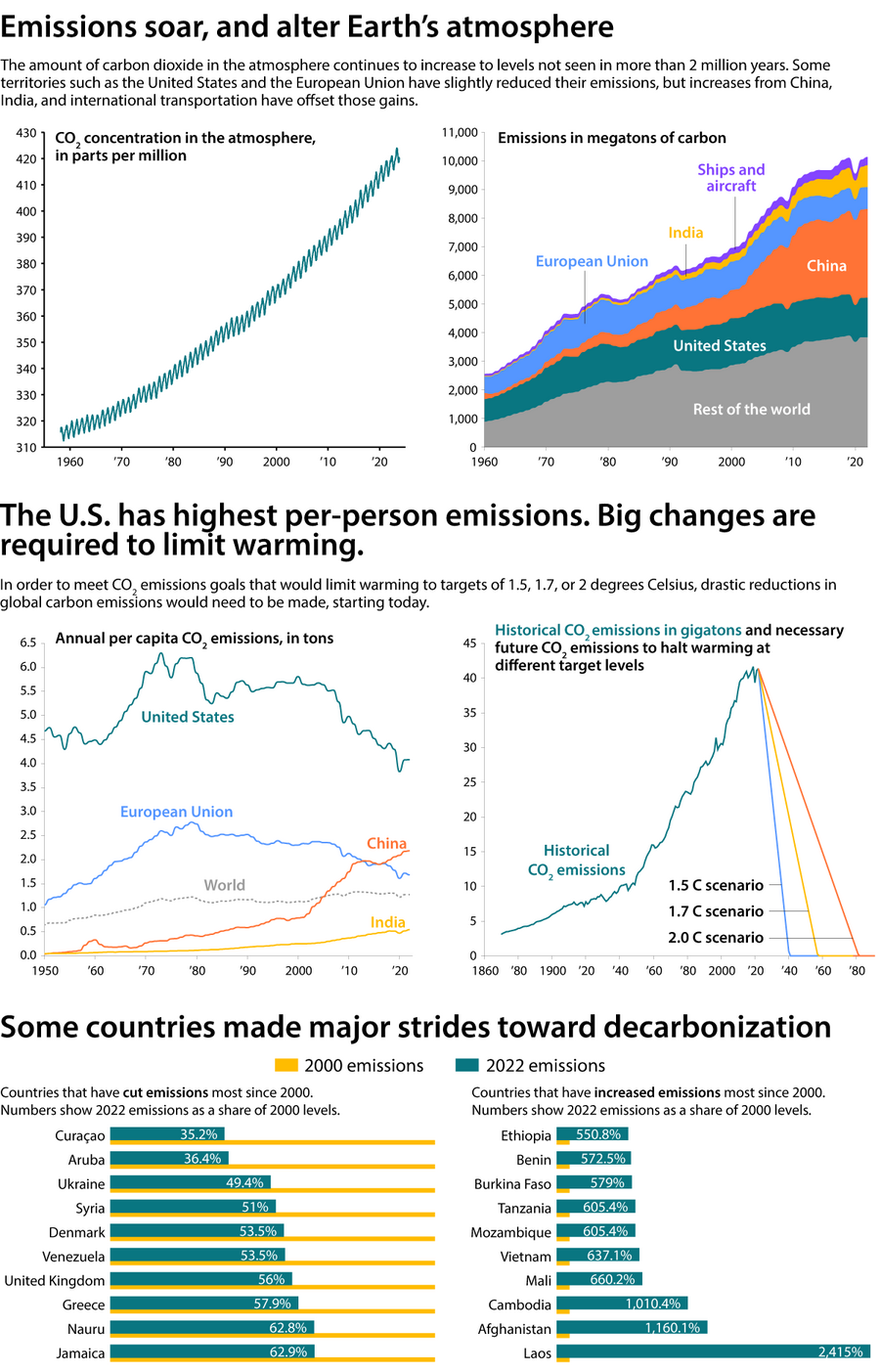
Mauna Loa Observatory, Global Carbon Budget

Patterns
The two-state solution is unloved but still indispensable
The prospects of an Israeli state and a Palestinian state living peacefully side by side seem as distant as ever, even hopelessly naive. Yet the two sides must inevitably live side by side, and a two-state solution remains the most practical way forward. The question is how to get there now.

- Quick Read
- Deep Read ( 4 Min. )
Ever since the state of Israel was created, 75 years ago, on land that Palestinians claimed, the idea of two states in Palestine has persisted as a way to make peace. And it has persistently failed.
But U.S. President Joe Biden is promoting the formula with particular urgency as he outlines his vision for a Middle East after the war in Gaza.
The geopolitical stakes are high. Although Washington’s main aim is to reopen at least the possibility of an eventual Israeli-Palestinian peace, that goal is only part of a broader postwar strategy.
The U.S. administration hopes to enlist like-minded partners in the region, both Western allies and key moderate Arab states, to help foster a politically stable, economically robust alternative to Iran, whose influence is growing, and its regional proxy armies like Hamas.
Mr. Biden is motivated to try harder by the knowledge that the leaders of Hamas and Israel are both viscerally opposed to compromise.
Today Mr. Biden, moderate Arab states, and much of the wider world seem to have concluded that the extraordinary violence of the past two months has made a serious and sustained new effort at such a compromise necessary.
Once again, the two-state solution – unloved, unwelcome, and unworkable though it has proved to be over the years – appears also to be indispensable.
The two-state solution is unloved but still indispensable

The contrast is jarring: between an inexorably escalating war in Gaza, and the almost mantralike declarations by U.S. President Joe Biden and other world leaders promoting their diplomatic vision of a postwar Middle East.
Especially since that vision – the “two-state solution,” with Israel and a Palestinian state living side by side in security, dignity, freedom, and peace – has been attempted without success ever since the establishment of the state of Israel in the 1948.
And now, due to the brutal Hamas attacks of Oct. 7 and the terrible civilian toll in Gaza, many Israelis and Palestinians are more reluctant than ever to talk peace.
Still, there is a web of compelling reasons the events since Oct. 7 have made the two-state solution more like a two-state imperative for Mr. Biden.
The geopolitical stakes are high. Although Washington’s main aim is to reopen at least the possibility of an eventual Israeli-Palestinian peace, that goal is only part of a broader postwar strategy.
The U.S. administration hopes to enlist like-minded partners, both Western allies and key moderate Arab states, to help foster a politically stable, economically robust alternative to Iran, whose influence is growing, and its regional proxy armies like Hamas.
Given the failure of past attempts to negotiate Israeli-Palestinian peace, it is hardly surprising that Mr. Biden’s promotion of the “two-state solution” has been greeted by a chorus of skeptics, including media pundits, think tank experts, and even former negotiators. A headline above one opinion piece last month in The New York Times perhaps best captured the mood: “The Two-State Platitude.”
So why, then, has Mr. Biden persisted in pressing the argument for a two-state peace?

The immediate catalyst has been the Israel-Hamas war, and not just for its brutality. The suffering and trauma on both sides are threatening to snuff out the merest thought of a two-state compromise in the immediate aftermath of the fighting.
But more importantly, the U.S. president feels a particularly urgent need to stand up now for his vision precisely because key leaders on both sides of the conflict want any compromise ruled out forever.
Hamas has long sought a single, Islamist state in Palestine and the elimination of the state of Israel.
And while Israeli Prime Minister Benjamin Netanyahu has sometimes paid lip service to the idea of a two-state peace, even before Oct. 7 he had made his opposition increasingly clear. The policy program of his current coalition, the most right-wing in Israel’s history, envisages Israel’s annexation of the occupied West Bank.
Mr. Biden’s focus on the two-state solution is an effort to keep at least the principle of Israeli-Palestinian compromise alive, not least because the prospect of open-ended conflict would leave Palestinians no alternative to Hamas, destabilize U.S.-allied Arab states, and embolden Iran.
But he’s also aware that mere words – two-state platitudes – will not suffice.
The practical steps that the United States and its allies might take will depend largely on the outcome of the current war. Will Hamas emerge hobbled, or sufficiently intact to claim a measure of victory? Will the Americans manage to enlist international support, and funding, to rebuild Gaza?
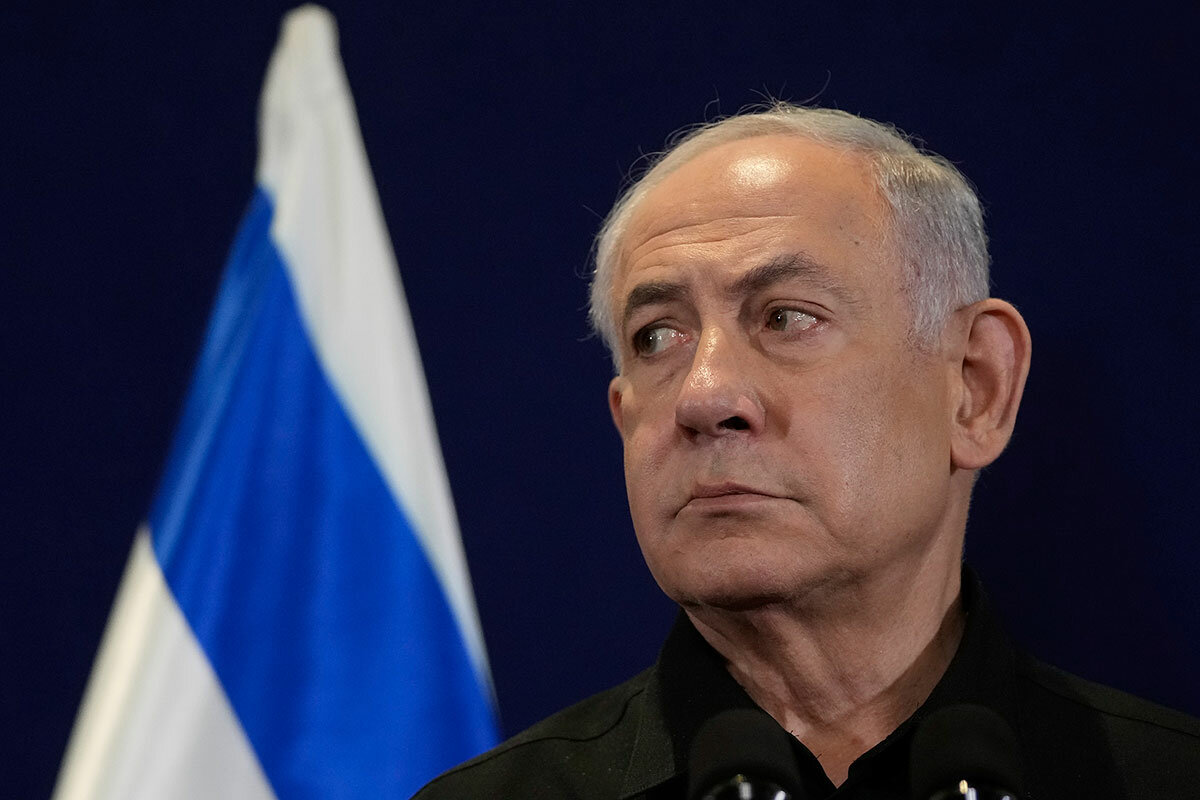
And will Mr. Netanyahu, blamed by many Israelis for the failure to prevent Hamas’ atrocities and abductions, hold on as prime minister?
President Biden appears to have decided that, at the very least, Washington must reengage diplomatically with the Israel-Palestinian conflict.
That, in itself, would represent a significant shift from the past two decades, under successive administrations, during which the U.S. concluded a peace agreement simply wasn’t possible and thus was not worth the investment of Washington’s political and diplomatic capital.
Mr. Biden’s immediate focus is likely to be less on full-scale peace than on reviving a peace process, explicitly based on the principle of a two-state compromise, with Arab and wider international support. That, too, would represent a change: Even before Oct. 7, there had been no meaningful Israel-Palestinian negotiations for nearly a decade.
The key question is whether a new negotiating initiative could yield visible, credible progress.
On one point, the skeptics are clearly right: All past attempts to secure a final, two-state peace have failed. In the wake of the war in Gaza, it’s hard to imagine any quick breakthroughs.
But the history of those failed attempts is complex, and not completely without hope.
Since 1947, when a nascent Israel embraced a United Nations General Assembly resolution backing two states in Palestine while Arab states rejected it, peace bids have foundered on a mix of action and inaction on both sides.
Still, the last major effort – a Camp David summit in 2000 at which President Bill Clinton tried to mediate agreement between Israel’s Prime Minister Ehud Barak and the late Palestinian leader Yasser Arafat – came closer to success than any previous attempt.
And today Mr. Biden, moderate Arab states, and much of the wider world seem to have concluded that the extraordinary violence of the past two months has made a serious and sustained new effort at such a compromise necessary.
Once again, the two-state solution – unloved, unwelcome, and unworkable though it has proved to be over the years – appears also to be indispensable.

Books
Bright colors, warm messages: Kids’ books to read and give
The amazing power of children’s books is to make us better people while also making us smile, or cry – or hungry. Why can’t the whole world be that way? Well, these books suggest that maybe it can be.

- Quick Read
- Deep Read ( 5 Min. )
A package of ramen noodles desperately wants to be popular like spaghetti. A stick creature offers an “alien” a tour of his beautiful corner of the world.
Picture books give voice and imagery to children’s experiences, from wanting to fit in at school to reveling in the wonders of nature. We’ve chosen a set of recent books that offers fresh outlooks, differing perspectives, and new frontiers to explore.
These books show the beauty and growth that comes with viewing the world through someone else’s eyes.
They also make the loveliest holiday gifts for the children in your life.
Bright colors, warm messages: Kids’ books to read and give
A stick creature offers an “alien” a tour of his beautiful corner of the world.
A package of ramen noodles desperately wants to be popular like spaghetti.
A collection of fairy tales from far-flung lands explores cultures and offers unique lessons.
These reads, and two more, all offer fresh outlooks, different perspectives, and new frontiers to explore. They show the beauty and growth that comes with viewing the world through someone else’s eyes.
They also make the loveliest holiday gifts for the children in your life.

A bond that transcends words
From the colored-pencil illustrations by Chuck Groenink to the tender prose by Tanya Rosie, “Grandpa Is Here!” is a touching tale about grandparents and a heartwarming ode to long-distance family relationships.
When Grandpa finally arrives, he’s brought a suitcase full of Persian spices, herbs, limes, walnuts, and saffron to make yellow rice. His beloved granddaughter, in turn, takes him on a tour of her world: woodland paths and grassy hilltops, friendly frogs and hungry horses. Despite their differences, grandfather and granddaughter forge a deep, special bond. She observes, “We speak different languages, Grandpa and I, but how we laugh and laugh and laugh.”
Quiet and contemplative, this book holds special resonance for readers of all generations who have welcomed family members from abroad. For me, it brought back sweet memories of a visit from Baba, my grandfather who journeyed from Hyderabad, India, laden with sweets and chocolate, to visit our upstate New York home. And for my kids, it’s a living story of regular visits from their Indian grandparents, Dada and Dadi, which include after-dinner romps in the yard and daily lessons in rolling fresh rotis and flaky parathas.
Like our pigtailed protagonist and her kindly, mustachioed grandfather, my kids speak a different language than their grandparents, but their bond transcends words.

Being your own special self
“I Want To Be Spaghetti,” by Kiera Wright-Ruiz and illustrated by Claudia Lam, is for all the kids who want blond hair and blue eyes, a name everyone can pronounce, a packed school lunch that isn’t torbogee or tikki or tamales. In other words, it’s for the kids who want to fit in.
Ramen wants to fit in, too. She wants to be spaghetti. Beloved, popular, beautiful spaghetti. But when Ramen is taken home from the grocery store, bathed in warm broth, and introduced to friends such as Nori, Chashu, and Narutomaki, who join the ramen party, she realizes how great it is to be herself.
Lam’s mangalike illustrations punctuate the story with humor and energy, a refreshing take on the story’s simple, direct message.
“I Want To Be Spaghetti” represents a full-circle moment for the author, who based it on her experience growing up and thinking she looked too different to be accepted. “I hope wherever you are right now that you know this,” Wright-Ruiz says in her author’s note. “You are perfect as you are.”
I hope that my kids – who are growing up in a world more accepting of different skin colors, languages, and foods – know this, too.

Sending readers on a quest
“Books Make Good Friends,” written and illustrated by Jane Mount, is a joyful celebration of books. Centered around a bookish protagonist named Lotti who loves to read but struggles to connect with those around her, this scrapbook-style picture book is packed with delightful surprises. Both my older kids, ages 7 and 10, found the vibrant art, hand-lettered commentary, and illustrated stacks of books wildly fun.
Throughout the book, readers spy Lotti reading a different book in a variety of settings: “Charlotte’s Web” in bed, “The Wondrous Workings of Planet Earth” on a picnic blanket during a hiking break. Like nosy commuters on a train, we wonder what she’s reading. An inset “recommended read” box quenches that curiosity with a sketch of the cover and a summary of the book, inviting readers to search out titles of interest.
My young readers found those stacks irresistible and spent stretches of time scrutinizing every title, exclaiming every time they recognized one.
With its immersive format and prompts for kids to explore different titles, “Books Make Good Friends” sent both my older kids, one an avid reader, the other less so, on quests to find recommended reads.
Every page of this interactive book offers a treat, even the endpapers, which contain a recipe for Lotti’s Friend-Making Cookies, chock-full of oats, pecans, and chocolate. (We tried the recipe together; it’s a keeper.)

Folk tales spread kindness
If “Grimms’ Fairy Tales,” “Aesop’s Fables,” and “1,001 Arabian Nights” had a globe-trotting, peacemaking grandchild, it would be “Folktales for a Better World: Stories of Peace and Kindness,” by Elizabeth Laird, illustrated by Mehrdokht Amini.
This collection of seven stories sweeps the world, offering readers glimpses of kindness and humanity in conflict-ridden lands.
The tales are both instructional and inspirational.
In Sudan, a reversal of fortunes and forgiveness unites an estranged father and daughter.
In Ethiopia, peace between warring clans is achieved only when their pride is, literally, thrown in a river.
In Yemen, an aging sultan chooses his successor with a simple, but revealing, question.
And in Syria, a lion teaches a woodcutter the perils of greed and the meaning of friendship.
Award-winning author Elizabeth Laird’s empathetic and emotional stories, and Mehrdokht Amini’s charming, layered illustrations, weave an immersive read that captivated my 7-year-old, who loved the dramatic stories, faraway settings, and concrete lessons.
For him, it’s become bedtime reading. I hope it helps him dream of a better world.

Eye-opening love of nature
In “Stickler Loves the World,” when an otherworldly, helmet-clad visitor appears in his corner of the woods, Stickler, a woodland creature covered in sticks, decides to show him around.
Stickler takes his alien visitor on a grand tour, rapturously pointing out the wonders of his world:
“Colors, bursting like fireworks! Flowers!”
“Feel it? Wait for it. There! ... It’s like a whisper ... but one you feel ... Wind.”
“Then there are these things dancing for us, falling, spinning, whirling, twirling, around and around!”
Stickler points with glee at a sky full of falling helicopter seeds.
When the visitor turns out to be a crow with a can stuck atop its head that is finally dislodged, Crow thanks Stickler for opening his eyes – literally and figuratively.
Author and Caldecott honoree Lane Smith’s quirky, endearing illustrations bring mystery and joy to the everyday phenomena that we often ignore: fluffy dandelion pappi; soft, cushy moss; reptilian-textured tree bark.
It turns out Stickler, with his delight in the bits and bobs around him, is not unlike my 2-year-old. Reading this book felt like seeing the world through his eyes, where every pine cone, rock, and leaf is a treasure to behold.
Other headline stories we’re watching
(Get live updates throughout the day.)The Monitor's View
A lesson in peaceful listening
- Quick Read
- Deep Read ( 2 Min. )
-
By the Monitor's Editorial Board
The responses by regional peacemakers to the war in Gaza during the past two months have highlighted how the Middle East is working toward a more integrated and peaceful future. A similar shift is underway in Africa, where neighboring nations have banded together to end a brutal civil war in Sudan.
Those efforts may now be on the cusp of a breakthrough. The leaders of Kenya, Ethiopia, Djibouti, and South Sudan are set to meet in coming days. Their goal is to chart a broadly inclusive process to restore peace and democracy. That alone would be significant. In seven months, the war has displaced more than 6 million people and rekindled ethnic violence in parts of the country still recovering from genocide a generation ago.
But the summit matters in another way, too. Coming just days after the war’s rival factions pressured the United Nations Security Council to close its political mission in Sudan, it reflects the utility of patient trust-building. Led by Kenyan President William Ruto, regional leaders have spent months listening and working to develop credibility with the warring factions and their international patrons.
A lesson in peaceful listening

The responses by regional peacemakers to the war in Gaza during the past two months have highlighted how the Middle East is working toward a more integrated and peaceful future. A similar shift is underway in Africa, where neighboring nations have banded together to end a brutal civil war in Sudan.
Those efforts may now be on the cusp of a breakthrough. The leaders of Kenya, Ethiopia, Djibouti, and South Sudan are set to meet in coming days. Their goal is to chart a broadly inclusive process to restore peace and democracy. That alone would be significant. In seven months, the war has displaced more than 6 million people and rekindled ethnic violence in parts of the country still recovering from genocide a generation ago.
But the summit matters in another way, too. Coming just days after the war’s rival factions pressured the United Nations Security Council to close its political mission in Sudan, it reflects the utility of patient trust-building. Led by Kenyan President William Ruto, regional leaders have spent months listening and working to develop credibility with the warring factions and their international patrons.
Such diplomacy rests on what Workneh Gebeyehu, executive secretary of the Intergovernmental Authority on Development, a bloc of East African nations, calls a collective “moral obligation to the peace and stability” rooted in dignity and the protection of innocent life. It’s proving persuasive. The United States and Saudi Arabia now see regional peace-efforts work as the key to restarting their halting diplomacy in Sudan.
“When African states propose a formula for addressing an African crisis, world powers often put aside their difference and back it,” wrote regional experts Alex de Waal and Abdul Mohammed in The New York Times this week.
The war broke out in April when two rival generals who conspired to overthrow a transitional civilian-led government turned their forces on each other. The conflict sparked parallel peace initiatives to keep a humanitarian crisis from creating wider instability in an already fragile region. Unifying those mediation efforts requires building trust among a broad array of foreign actors with competing economic and strategic interests in Sudan.
One outcome of the summit next week might be a division of labor. Amgad Fareid Eltayeb, a fellow at the European Council on Foreign Relations, has argued for spreading the duty to meet military, political, and humanitarian needs of Sudan among various international mentors with a shared goal of enabling the Sudanese people to determine their own future.
That approach reflects what may be an emerging good at a time of fragmenting blocs of global power. As authors Jared Cohen and Ian Bremmer wrote in Foreign Policy Wednesday, the critical adhesive for a world in balance is trust: “At the global level, credibility makes alliances and deterrence work, increasing cooperation and reducing the risk.”
In Sudan, as in Gaza, new constellations of cooperation are forming. A new era of listening among nations may be underway.

A Christian Science Perspective
Each weekday, the Monitor includes one clearly labeled religious article offering spiritual insight on contemporary issues, including the news. The publication – in its various forms – is produced for anyone who cares about the progress of the human endeavor around the world and seeks news reported with compassion, intelligence, and an essentially constructive lens. For many, that caring has religious roots. For many, it does not. The Monitor has always embraced both audiences. The Monitor is owned by a church – The First Church of Christ, Scientist, in Boston – whose founder was concerned with both the state of the world and the quality of available news.
The promise of immortality here and now
- Quick Read
- Read or Listen ( 4 Min. )
-
By Thomas Mitchinson
Gaining a higher sense of life as originating in God, not matter, brings healing, redemption, and regeneration.
The promise of immortality here and now
A while back, I was up all night quite ill. As morning broke, I asked my wife to read to me that week’s Bible Lesson from the “Christian Science Quarterly.” One passage from “Science and Health with Key to the Scriptures” by Mary Baker Eddy really spoke to me. Echoing passages from Paul’s letters to the early Christians (see I Corinthians 15:54 and II Corinthians 5:4), it states, “Every quality and condition of mortality is lost, swallowed up in immortality” (p. 215).
It had felt as if I were being swallowed up by this illness, but this passage made me realize that I had it backward. Evil can’t swallow good. Good swallows up evil. The immortality of God, divine Life, was present, and I could trust the healing power of God. I began to feel the comforting, gentle power of divine omnipotence envelop me, and in a short while I was well.
As usually happens in a healing brought about through Christian Science, what took place was more than a physical cure. Specific spiritual facts had come to thought, revealing more about God and about man’s present immortality as God’s child. Each day we have the opportunity to realize that God is divine, unending Life. This Life gives us the ability to overcome sin, disease, and limitations of all kinds by realizing that our true life is not biological or psychological but divine Life’s immortal expression.
This promise is not about an event at the end of life but about what happens throughout life here and now. It’s about swallowing up the fear of disease with trust in God, silencing the cacophony of physicality and sin with peace and purity, and revealing our true selfhood as spiritual, not material. This brings healing.
Step by step we can realize and prove that no condition is ever beyond the healing power of divine Life and that we are never in a situation where God’s guidance cannot direct and save us. Divine Life is always our life. Yielding to this truth and God’s governance leads us out of the most dire circumstances, as shown in the biblical account of Jonah.
Jonah was in trouble. He had disobeyed God’s direction to go to the great city of Nineveh and expose the evil there and had instead taken a ship in the opposite direction (see Jonah 1-3). When a storm threatened the lives of everyone on the ship, Jonah told the mariners to throw him overboard. He then found himself drowning in not just water but a sea of remorse.
But that wasn’t the end of his story. The Bible says, “Now the Lord had prepared a great fish to swallow up Jonah.” The spiritual sense of this story reveals that God was present, protecting Jonah and giving him the love and direction he needed to conquer the mortality of willfulness, regret, and failure, and even the mortal threat of the waves.
As a result, he became inspired and confident in his trust in God and willing to be obedient to God’s will – which sometimes feels hard but is always good. The fish deposited him onto dry land, and he was able to go forward, following God’s guidance and bringing repentance, reformation, and healing to the people of Nineveh.
This is what is so profoundly wonderful about understanding immortality. We realize that our life is not at the mercy of fear, pride, or doubt; nor is it in the grip of disease and death. Our life is the expression of divine Life, now and always.
Like Jonah, we may need to reexamine our motives or even turn our life in a different direction. But we can allow God, divine Love, to help us forgive not only others but ourselves. We can let divine Mind, also a synonym for God, help us see everyone’s (including our own) innate perfection as God’s child. And we can permit infinite Truth to take away the hurts of the past and reveal the permanent love and joy God has for us now. In other words, we can allow the immortal reality of divine Life, Truth, and Love to swallow up our worry and anger with peace, hope, goodness, and security.
This is immortal Life’s divine activity in individual lives – the truth that Christ Jesus lived so fully – and it heals mentally and physically. This is the only true activity going on – divine healing producing health, harmony, and peace, because in God’s allness, every condition, trait, or fear of mortality is being swallowed up in immortality.
Adapted from an editorial published in the Aug. 7, 2023, issue of the Christian Science Sentinel.

Viewfinder
Illuminating moments

A look ahead
Thank you for joining us today. To send you on your way, we have an extra story about the end of U.S. Sen. Tommy Tuberville’s efforts to block military promotions. Monitor staff writer Anna Mulrine Grobe looks at the toll paid by the military and military families, and at the sense of trust that will need to be rebuilt. You can read the story here.


